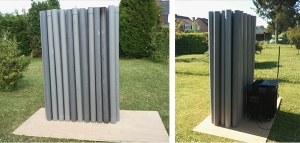Phononic crystals are artificial composite materials formed by periodic arrangements of inclusions inserted in a matrix. Several classes can be distinguished according to the physical nature of the constituents. One can thus quote the solid/solid (respectively fluid/fluid) composites where all the constituents are solids (respectively fluids) and the mixed composites formed at the same time of solids and fluids. Because of their periodic structure, phononic crystals can present under certain conditions (geometry of the inclusions network, volume fraction of the inclusions, shape of the inclusions, …) forbidden bands, i.e. frequency domains in which the propagation of waves is forbidden. Their application to sound insulation follows naturally from this property. However, in these structures, other remarkable properties can also be highlighted, in particular the negative refraction, which makes it possible to focus the acoustic waves by virtue of the law of Snell-Descartes.
Since their discovery in the early 1990’s, phononic crystals have been intensively studied as acoustic screens, but in most of these studies, their performances are established only by the experimental determination of the reflection and transmission coefficients of acoustic waves. In this work, in addition to a transmission study, we sought to analyze how sound is perceived by a listener when it passes through an acoustic screen made of a phononic crystal.
 The phononic crystal considered here is a mixed composite formed by a triangular network of PVC tubes 10 cm in diameter, 1 m long, spaced 12 cm apart, and placed in the air. This crystal was designed to have two characteristics in the audible frequency range: two disjointed band gaps (one from 1080 to 1610 Hz and the other from 2500 to 2960 Hz) separated by a negative refraction band, with a focus around 1700 Hz. Experiments, carried out in air, as well as numerical simulations highlight these two effects: a very attenuated transmission in the forbidden bands but stronger for frequencies around 1700 Hz, which can be associated with a phenomenon of focusing of the sound.
The phononic crystal considered here is a mixed composite formed by a triangular network of PVC tubes 10 cm in diameter, 1 m long, spaced 12 cm apart, and placed in the air. This crystal was designed to have two characteristics in the audible frequency range: two disjointed band gaps (one from 1080 to 1610 Hz and the other from 2500 to 2960 Hz) separated by a negative refraction band, with a focus around 1700 Hz. Experiments, carried out in air, as well as numerical simulations highlight these two effects: a very attenuated transmission in the forbidden bands but stronger for frequencies around 1700 Hz, which can be associated with a phenomenon of focusing of the sound.
Additional studies, both numerical and psycho-acoustic, were then carried out in order to analyze precisely how sound is perceived by a listener when it passes through an acoustic screen made of a phononic crystal of finite thickness. First, a quantity frequently used in auditory perception, the « 1/3 octave loudness », was calculated using the results of numerical simulation of the acoustic field obtained in three different situations: propagation in free field (CL), i.e. in the absence of any obstacle between the sound source and the listener, propagation through a phononic crystal (CP) of finite thickness, and propagation through a rigid wall of identical dimensions to those of the phononic crystal (M). This numerical study shows a significant decrease in loudness in the (CP) situation for frequencies belonging to the forbidden bands; a decrease of a level similar to the (CP) case being observed in the (M) situation. Moreover, in situation (CP) and for frequencies close to the focus, the loudness reaches higher values than in the 2 other cases. In a second step, and in order to study if the differences and similarities observed in the loudness for the different propagation schemes considered ((CL), (CP) and (M)) are perceptible by « human » listeners, a listening test was carried out with 25 volunteers. They were exposed to various sound stimuli obtained by convolving « third octave noises » with the impulse responses calculated in the situations (CL), (CP) and (M) for different frequency bands. These listening tests corroborate the loudness analysis. The situation (CP) leads well on the one hand to a lower sound level, of the same order as in the case (M), for the frequencies belonging to the forbidden bands. On the other hand, a higher sound level in case (CP) is felt in the frequency range of the focus, giving the illusion to the listener of having a sound source closer to him.
This study shows that an effective acoustic screen for audible frequencies can be designed from a phononic crystal of simple structure and made of usual materials; this effectiveness being of the same order as that obtained with a solid solid screen. This study should make it possible to propose interesting alternatives to the usual noise barriers. Indeed, the latter, which are most often massive continuous walls, have a negative visual impact on the surrounding landscape, are opposed to the passage of ambient light, have a very high resistance to air flow and are made of materials that are not very or not at all bio-compatible. We can then imagine new acoustic screens based on phononic crystals in which the inclusions would be trees or vegetated poles, and integrating perfectly in their environment…














